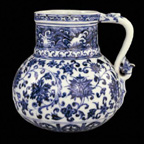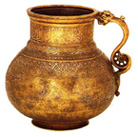
Ming dynasty, early 15th century CE
From Jingdezhen, Jiangxi province, Chine
Underglaze blue porcelain
Height: 14 cm
Acquisition number: # OA 1950.4-3.1
Gift of E.B. Havell
Image courtesy of the British Museum (copyright reserved)

Timurid dynasty, 1461-62 CE
Believed to be from Herat
Brass inlaid with silver
Height: 13 cm
Acquisition number: #943-1886
Image courtesy of the Victoria and Albert Museum (copyright reserved).
Underglaze-blue decorated porcelain, commonly called " blue-and-white," is believed to have been first manufactured in China during the Yuan dynasty (AD 1279-1368). By the fifteenth century, however, the demand for blue-and-white porcelain in Islamic Asia and in the Middle East was so great that the majority of these ceramics manufactured in China were made specifically for export. With this market in mind, Chinese kilns began experimenting with forms that would appeal specifically to Islamic consumers.
The blue-and-white porcelain jug we see here is an example of such a design. When compared with a contemporaneously designed Timurid brass jug, we see the forms of the two vessels are virtually identical. The glaze patterns on the Chinese vessel attempt to simulate the type of floral scrolls commonly found in Timurid designs, but still they largely retain their Chinese flavor, including the introduction of such non-Timurid elements as the breaking wave pattern on the neck.
One of the most interesting elements common to both jugs is the dragon-neck handle. Here we have an example of the dragon motif being reworked by Chinese artisans, in order to reflect a particularly Timurid interpretation of what was originally a traditional Chinese design element.